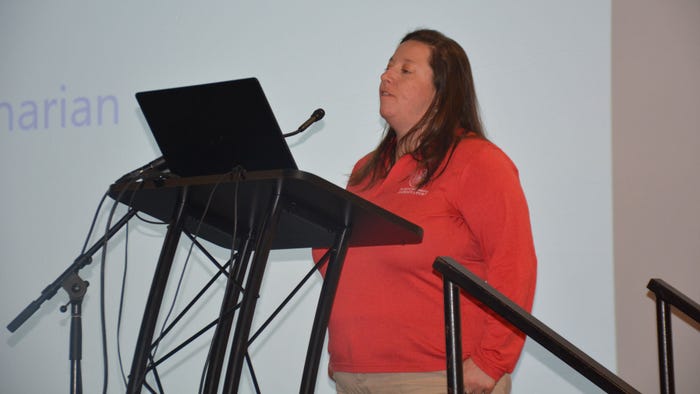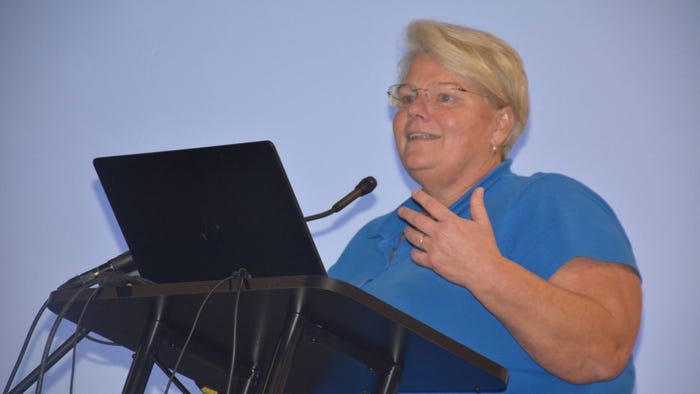
Benjamin Franklin once said, “An ounce of prevention is worth a pound of cure.”
Who would have thought 287 years later some people would reference Franklin’s famous quote in relation to current events? But when it comes to highly pathogenic avian influenza (HPAI), it makes perfect sense, said Georgie Cartanza, poultry Extension educator with University of Delaware Cooperative Extension.
That’s because most of last year’s cases — 80% confirmed through DNA testing — happened because of someone stepping in and bringing the virus into a house, she told a group of poultry growers at Delaware Ag Week in Harrington.
So, what ounce of prevention is most effective? Dedicated boots or disposable boots for each house, and foot baths at each door, are the best prevention measures.
“Meaning each house has its own pair, and it doesn’t leave the poultry house, never gets outside,” she said. “So set up a plastic container with a lid, put the shoes in there so it stays covered and not exposed. You travel from one house to another with different shoes.”
Foot baths offer an extra layer of virus transmission prevention, but remember that they are only for disinfecting footwear, not cleaning, she said. If any organic material is on your shoes, clean it off. Shoes with minimal tread are best to prevent litter and other materials from sticking.
If a cellphone is being brought into the house, or you are bringing tools in to fix something, they should all be cleaned and disinfected, she said. And if visitors are being brought in, hairnets, masks, coveralls, boots and gloves are essential, although limiting visitors during times of high virus transmissibility risk is probably best.

MORE WIDESPREAD: Karen Lopez, state veterinarian in Delaware, said the equally split number of commercial and backyard poultry flocks affected by HPAI points to big differences between the current outbreak and the last severe outbreak of HPAI in 2014-15. This time around, the virus is more widespread.
Securing the outside compost area is crucial to prevent sick wild birds, such as vultures, and other animals from coming onto the farm. Cartanza said the most common mistakes she sees growers make is not using enough litter or carbon in the compost pile, and not putting enough of a base down.
“If you’re doing a good job composting, you shouldn’t see vultures,” she said. “But not done right, vultures will invade the farm.”
Keeping birds away
Karen Lopez, state veterinarian in Delaware, said the equally split number of commercial and backyard poultry flocks affected by HPAI — 396 commercial flocks and 328 backyard flocks in the U.S. in 2022 — points to big differences between this current outbreak and the last severe outbreak of HPAI in 2014-15.
That outbreak, she said, affected mostly commercial poultry farms with lateral spread between farms because of lax biosecurity and slow depopulation of poultry houses.
This time around, the virus is much more widespread.
"What we've seen is that there have been such a great, great number of wild birds and a variety of species of wild birds that have been infected with HPAI that are not only individually introducing the virus to commercial farms, but also introducing the virus to backyard flocks, which obviously just intrinsically oftentimes don’t have very good biosecurity,” Lopez said.
“The birds are out in the open; they maybe be comingling with wild birds if there is water on the property. If those wild birds are attracted to whatever food is being set out for these backyard poultry, that’s something that we’re really seeing this last year.”

PREVENTING DISASTER: Georgie Cartanza, poultry Extension educator with University of Delaware Cooperative Extension, said dedicated boots or disposable boots for each house — and foot baths at each door — are the best prevention measures against HPAI.
Black vultures are the most susceptible bird of prey to HPAI, said Kevin Sullivan of USDA-APHIS in Maryland, adding that he has seen sites in the state with more than 500 dead vultures that later lab testing confirmed were infected with the current HPAI strain circulating.
Dozens of wild bird species are known carriers of the current HPAI strain, he said, from eagles to hawks, owls and many species of waterfowl. Labs right now are so overwhelmed from testing birds, he said, that any dead bird suspected of dying from virus is assumed to have died of HPAI.
“The key here is biosecurity” and exclusion, Sullivan said. “So, if we can keep the birds from getting into contact with your birds, just that much better.”
Mice, rabbits and other mammals have also been found to be disease carriers, so excluding any wild animal from possible food, water or shelter on the farm is important because that is what will attract them.
“Check your manure sheds, standing water, food, feed,” Sullivan said. “You have to identify and manipulate what attracts them, remove the sources that attract them.”
Using wire grids, predator decoys, scarecrows and other devices can be effective, but a combination of “scare tactics” is even better, he said. For example, effigies and decoys can be placed in a field or on a structure, but Sullivan said these rarely work by themselves unless they are followed up with some sort of hazing or harassment — such as mylar tape, propane cannons or even some pyrotechnics.
Except for eagles and endangered bird species, Sullivan said any hazing or harassing of birds can be done, legally, without a permit.
Removing nests of pigeons, starlings and house sparrows around poultry houses is allowed, too, he said, but most other birds are protected by the Migratory Bird Treaty Act, meaning any removal or hunting of these birds can only be done via permit.
And if you are hunting, Cartanza said to stay out of the poultry house for at least 48 hours to ensure virus doesn’t somehow trickle in.
Sullivan said the best way to get a permit, or to check a state's regulations regarding bird hunting or nest removal, is to contact the local USDA-APHIS office or any state game management agency.
About the Author(s)
You May Also Like






